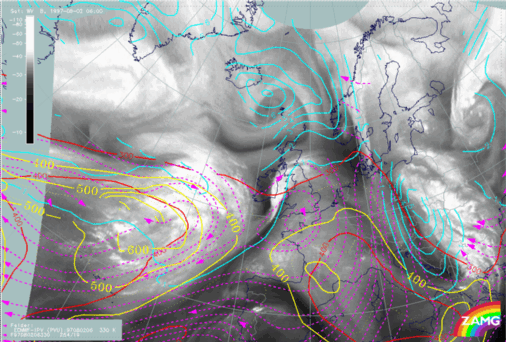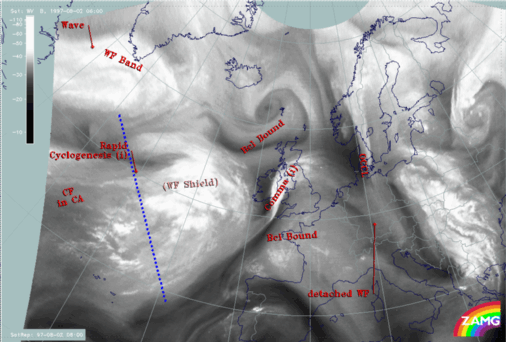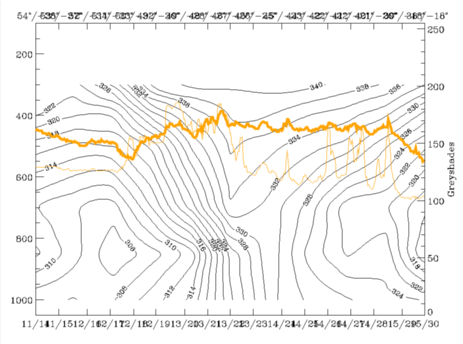02 - 03 AUGUST 1997 - RELATIVE STREAMS AND CONVEYOR BELTS FOR 02 AUGUST 06.00 UTC
by ZAMG
For the conceptual model
Rapid Cyclogenesis there are also typical parameters relating to isentropic surfaces. Typical relative streams can be
observed:
- A rising and splitting relative stream from southern directions on low isentropic surfaces
- A dry intrusion on high isentropic surfaces.
|
02 August 1997/06.00 UTC - Meteosat WV image; position of vertical cross section indicated; SatRep overlay: names of conceptual models
|
02 August 1997/06.00 UTC - Vertical cross section; black: isentropes (ThetaE), orange thin: IR pixel values, orange thick: WV pixel
values
|
|
|
|
The left image shows the vertical cross section line which is chosen perpendicular to the western part of the Rapid Cyclogenesis area. The vertical cross section itself (right image) contains a distinct downward inclined cold front zone with a surface front line close to 45N/25W. The high satellite pixel values of the front can be found on the rear side of the surface front. The WV minimum at 50N/32W represents the Black Stripe of dry air involved in the Rapid Cyclogenesis process. The isentropic surface 330K is on the top of the frontal surface.
02 August 1997/06.00 UTC - Meteosat WV image; cyan: potential vorticity 330K, red: isobars for potential vorticity, magenta:
relative streams 330K - system velocity 254° 19 m/s, yellow: isobars for relative streams

Relative streams on this surface clearly show a strongly rising Warm Conveyor Belt in the area of the Warm Front Shield. In the area of the Black Stripe the relative stream is from the rear side of the cloud system, which is in good accordance with the distribution in an ideal case. In this area the isentropic surface is higher than 400 hPa but relative streams do not transport stratospheric air there. Bearing in mind that the jet axis in the numerical model has to be shifted northward in order to correlate better with the WV features, such a movement would also lead to a better discrimination between the warm conveyor belt and the relative stream from behind compared to the cloud features.
Summarizing these facts, the physical background necessary for a Rapid Cyclogenesis is supported by isobaric and isentropic parameters, but some of the main parameters are weaker than described in the classical case of such a conceptual model. This is especially true for the surface minimum which is weak and extended over a large area, and also for the WA maximum.





